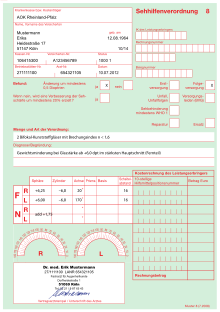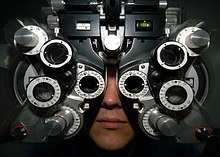Refraction (optics)
In optometry and ophthalmology, the term axial refraction ( lat. Re 'back', frangere 'break') describes the refractive power of the optical correction with which a certain eye creates a sharp image of an object at infinite distance without accommodation . If this value is zero, one speaks of normal vision or emmetropia , otherwise of ametropia .
A distinction must be made between an objective refraction, which is measured using an apparatus arrangement and determined by the refractive properties of the eyeball , and the subjective refraction, which requires information from the person examined about the perceived image sharpness and takes into account the influence of other variables on perception.
Determination of the objective refraction
The methods for determining the objective refraction (refractometry) are based on the infrared projection of objects onto the fundus, the (visible or) measurable image of which is brought into focus with the help of upstream lenses or which are brought into coincidence.
In retinoscopy (also known as retinoscopy or shadow samples ), a virtually infinite light source is used as an object, the "focused" image of which consists of uniform illumination of the entire fundus. The retinoscopy can be carried out with simple means (retinoscope and measuring glasses or glass strip), but requires the examiner to have great experience in the methodology and a corresponding expenditure of time. In certain situations, such as with small children or with a lack of compliance , skiascopy is often the most suitable method for objective refraction determination.
Auto refractometers are devices that automatically project and focus with photosensors and image processing. They require little experience in operation, are quick, but are expensive compared to retinoscopy. The manual refractometers have now been replaced by automatic devices from the market.
The results of the objective refraction measurement can be falsified by the accommodation . The determination of the objective refraction therefore provides the most precise values after drug paralysis of the ciliary muscle ( cycloplegia ) or by Mohindra skiascopy - a procedure that enables comparable values without cycloplegics.
Determination of the subjective refraction
The determination of the subjective refraction (often also called “adjustment” or “glasses adjustment”) can also be done without prior determination of the objective refraction. However, it is much easier and more reliable if the objective values have been determined beforehand. The person to be examined is systematically presented with different lenses one after the other and asked about an improvement or deterioration of the visual impression. As a rule, those optotypes that are also used to determine visual acuity are offered as objects for viewing. The selection and provision of the lenses can be accelerated by using a phoropter , an apparatus that can be used to switch quickly between different lenses. For this process, the “trial glasses” that used to be used are used from time to time. The examination is continued until no subjective improvement in visual acuity is achieved by changing the correction values offered. The refractive power of the lenses selected in this way is then the subjective refraction, taking into account the examination distance.
The subjective refraction determination is usually not carried out in cycloplegia (see above). Therefore, when selecting the lens, the examiner must take into account that the result can be influenced by accommodation.
Refraction and glasses

The value of the subjective refraction can often be used directly as a spectacle value . However, viewing habits such as B. constant, involuntary accommodation can lead to the fact that glasses corresponding to the subjective refraction value are not perceived as optimal. In exceptional cases, this can also lead to a correction that enables optimal visual acuity to be perceived as subjectively more unpleasant than a correction that possibly conveys a slightly poorer visual acuity . In order to recognize such subjective “glasses intolerance” in good time, a wearing test can be carried out. As a rule, however, the subjective refraction determination is aimed at the optimal correction to achieve the best possible visual acuity.
There can be subjective differences in the monocular refraction determination of the respective right and left eye compared to the binocular visual impression, especially with different refraction ratios ( anisometropia ). A determination of the future correction of the right and left eye is therefore always accompanied by a binocular check of the values determined.
An ophthalmologist transfers the determined values into a prescription for a visual aid , which is given to the optician to make the glasses. Myopia and farsightedness are corrected with so-called spherical lenses, astigmatism with cylindrical lenses , which only have an effect on a certain axis. The value of a spectacle lens therefore consists of a spherical component and possibly a cylindrical component with the designation of its axis position.
Since the examiner is largely dependent on the information provided by the person being examined when fitting the glasses, in the event of a dispute he is usually only liable for the professional implementation of the adjustment, not for the success of the glasses.
TABO scheme
The axis positions for cylindrical or prismatic corrections can be clearly defined using the angle division of the TABO scheme . The name TABO comes from the former T echnical A CoMMittee for B grooves o ptik who has proposed this scheme in 1928.
With the TABO scheme, the observer is facing the patient. The observer aligns two circles with numbering of the axes from 0 ° to 180 ° counterclockwise on both eyes of the patient, the zero direction being on the right horizontal - i.e. temporal on the left eye of the patient . The zero line of the TABO scheme through the reference point of the spectacle lens is called the "lens horizontal" or "grinding axis". After the "International System" with opposite angular divisions for both eyes (0 ° nasal, right counterclockwise and left clockwise) could not prevail, the German TABO scheme is the industry standard today.
A TABO scheme from 0 ° to 180 ° is usually shown on vision aid regulations. The doctor can also draw in the axis positions there.
Refraction measurement in children
At least the first objective refraction determination is always carried out in cycloplegia in children . This is the only way to correctly determine the exact values of an ametropia, since otherwise the existing accommodation impulse could falsify the measurement to a considerable extent. The drops are prepared either in the ophthalmologist's office or, especially in the case of small children and infants, at home by the parents. Depending on the age, either the subjectively optimal glass thicknesses for the patient are found out in a further examination, or the lens is determined based on the previously measured, objective results.
If a strabismus is present, a so-called full correction is prescribed. This corresponds to the objectively measured values minus 0.5 diopters of the arithmetic value of the sphere. In the case of hyperopia, this leads to a slight undercorrection and in the case of myopia to an overcorrection, in order to allow a low level of accommodation in the distance. In certain cases, so-called prisms are also incorporated into the glass or glued on as a film. Here, further values about prism strength and base position are documented or entered in the glasses prescription. If there is no strabismus, the spectacle lenses are generally weakened even further with regard to their spherical component in order to take into account to a certain extent the own accommodation impulse that is normally present for the corresponding age. Ultimately, however, the basis for determining the glasses is the totality of the findings.
See also
literature
- Hermann Pistor : The methods of objective refraction determination with the simple ophthalmoscope. Weinbrenner publishing house, Stuttgart 1948
- Kay-Rüdiger Harms, Michael Hornig: The practice of retinoscopy. DOZ-Verlag Optical Specialist Publication GmbH, Heidelberg 2011, ISBN 978-3-942873-03-1 .
- Herbert Kaufmann: Strabismus. 3rd completely revised and expanded edition, Thieme, Stuttgart December 10, 2003, ISBN 978-3131297235 .
- Theodor Axenfeld (founder), Hans Pau (ed.): Textbook and atlas of ophthalmology. 12th, completely revised edition. Gustav Fischer, Stuttgart et al. 1980, ISBN 3-437-00255-4 .
Individual evidence
- ^ Herbert Kaufmann: Strabismus. With the collaboration of Wilfried de Decker et al. Enke, Stuttgart 1986, ISBN 3-432-95391-7 .


